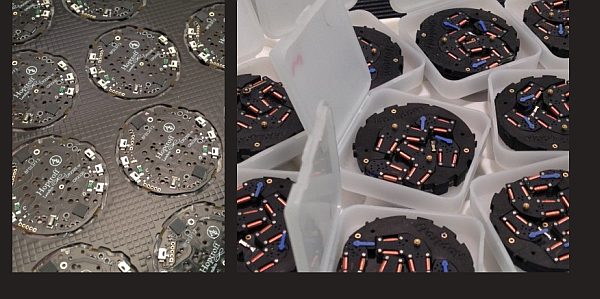
ABTW: With the prototype dial you’ve pictured, it shows a very complex timepiece. How do you anticipate that this will impact usability and readability?
RH: At 82mm diameter, it’s quite big, so the dials are relatively readable. Readability and operability are important issues for us. So taking a noon sight requires only a sextant and two button presses. Then bang! You know where you are on the planet to within a mile. No GPS, no radio, just you, the watch, the sextant and the sun.ABTW: What is the anticipated battery life for the watch?
RH: The atomic physics unit consumes a lot of power. The watch is as big as it is, not just because of the atomics, but because of the battery needed to power it even with the latest Lithium Polymer technology. That said, it’s smaller than both the Harrison H4 and the Patek Calibre 89, so I think we’ll be forgiven.
But to answer your question, it’s a trade-off between accuracy and power. Someone who wants to maintain absolute atomic accuracy will need to charge as regularly as their phone. For navigational accuracy, the low power modes will be fine. It could function for years without recharge and still be by far the most accurate watch in the world.
ABTW: Will the time and date be set manually on the watch, or will it pull the radio signal from the atomic clock observatories to set a baseline?
RH: We’re still thinking about the best way to do this. I think we’ll need at least two methods, to suit your circumstances. At one end pressing a sync button at the top of the hour. At the other, electrical setting for a tight time definition if a decent time source such as GPS is available. What is clear is that for navigational purposes, so long as you can set time to within a fifth of a second, the timekeeping drift is what counts. Beyond that, your sextant becomes by far the biggest error factor. My temptation is to simply take each one up Westminster Bridge, wait for the top of the hour and press the sync button when Big Ben chimes. How about that? Atomic, set by Big Ben.

ABTW: It’s noted that there’s a Bluetooth module incorporated into the watch – what is the anticipated usage of this radio?
RH: Bluetooth is integrated into all our products for configuration, time setting and, in some cases, actually obtaining data to display. But in the No.10, it plays a relatively minor role for hand alignment and diagnostics. The timepiece has to function without reference to any external signals – if you’re at sea and a wave washes down the hatch and fries all your other electrical equipment, the No.10 will still be there for you.
ABTW: There are 60 LEDs incorporated into the design – what will these be used for?
RH: We’re playing with the idea of a repeater that won’t wake your partner up – because it uses light not sound! But this is still at a very experimental stage, and I’m not sure if we will actually implement it in the finished product.
ABTW: When will the watch be formally launched?
RH: We’ll show it for the first time at Salon QP in November 2013. But this is a multi-year project, so I expect it to be ready by late 2014 at the earliest. It’s nearly killed me as it is. I’ve never designed something so complex.
ABTW: And then last (but not least) – what do have coming up next for the Hoptroff brand?
RH: What’s next? A watch that makes ice cream. At least that’s what my niece told me to do.
Our thanks to Richard to have taken the time to give us some insight into what he’s working on. I don’t know about you, but I’m very interested (and curious) to see how this intriguing bit of tech wizardry plays out! Let us know what you think – would you want a watch that had its own atomic clock in it? Or are you content to rely on a radio signal (or manually setting a watch against some other source)? hoptroff.com
